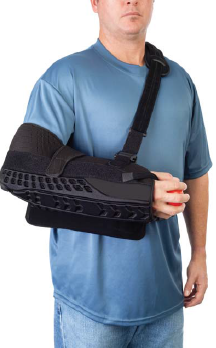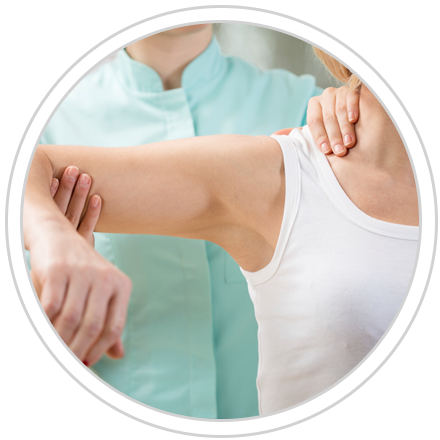Shoulder Replacement Surgery
 After your surgery is complete, you will spend approximately one hour in the recovery room, also called the PACU (post-anesthesia care unit).
After your surgery is complete, you will spend approximately one hour in the recovery room, also called the PACU (post-anesthesia care unit).
From there, you will be transported to the orthopedic floor (or whichever floor is determined to be the most appropriate for you if you have underlying health problems, such as a heart condition). You will likely remain on this floor until you are discharged.
Frequently Asked Questions Following Shoulder Surgery
- The hospital stay is usually 1-2 days.
- Home health staff may be a service ordered by your surgeon. They regularly assist in your care to assure your safety and compliance with therapy, safety, and medications.
- Some patients require extended convalescence and upon discharge from the hospital transfer to a skilled nursing facility or other rehabilitation facility (SNF). If this is the case, the case manager will arrange the details of your transfer as your insurance requires.
- You will be given ice chips and sips of water in the immediate post-operative period. Your nurse will slowly advance your diet to include clear liquids such as apple juice, Jell-O, and eventually solid foods. The slow transition to regular food is focused on minimizing post-operative nausea from anesthesia.
- You may resume normal activities as directed by your surgeon.
- Wear the sling at all times for at least 6 weeks. The sling may be removed for showers & when performing home exercises. In addition, if sitting in a controlled environment (i.e. watching television or reading a book), you may remove the sling and have arm support by pillows.
- Do not use your arm to push yourself up in bed or from a chair. This requires too much force on the surgically repaired muscles.
- Sleep in your sling for 4-6 weeks post-surgery.
- Walking is good!
- Follow the program of home exercises as detailed by your surgeon. Do the exercises 2-3 times a day for a month, or as directed by your surgeon (see diagrams on pages 14-15). You can expect very light activity for the first 6 weeks.
Most patients sleep in a recliner or propped up on pillows for the first 2-3 weeks post-surgery. - Try not to overuse your shoulder. It is easy to do if this is the first time you have been pain free in a long time. Early overuse of the shoulder may result in later problems.
- Do not lift anything heavier than a cup of coffee for the first 6 weeks after surgery.
- Do not participate in contact sports or do any heavy lifting (more than 10 pounds) for at least 6 months, or as directed by your surgeon.
- You will be given a “shoulder kit” while in the hospital. This consists of a bar, a pulley system, and elastic bands. Your Physical Therapist and surgeon will instruct you on the use of the shoulder kit.
- If you receive your ultra sling before surgery, it is a good idea to practice putting it on and taking it off.
- Shoulder therapy begins the first morning after the procedure.
- A physical therapist will see you on the day of surgery to get you out of bed.
- Most patients perform the exercise program directed by your surgeon at home for 4 weeks.
- A physical therapist will start gentle range of motion exercises in the hospital.
- After approximately 4 to 6 weeks your surgeon will direct an advanced plan for your continued physical therapy.
- It is important that the wound remains clean.
- Keep ice packs (a bag of ice wrapped in a towel or pillow case) or a cold therapy wrap on the surgical area for 20 minutes, 6-8 times/day, for the first 2 days following surgery, and as desired after that. This not only helps with swelling, but discomfort as well.
- It is important to always have a washcloth, pillow case, or other skin barrier between your skin and the cold source to prevent possible “freezer burn”.
- Check the incision daily for signs of infection. Signs of infection may include a foul smelling, greenish or yellowish discharge; increased pain or redness over the incision site; an opening of the incision; fl u-like symptoms; or a temperature above 101.5°.
- hould you develop drainage from the wound, fever, chills, persistent headache, nausea or vomiting, notify your physician’s office immediately.
- Change dressings as necessary, or as otherwise directed.
- Your surgeon may need to remove stitches or staples.
- This is often completed about 1-2 weeks after the operation.
- Your surgeon may use a special skin glue to close your wound. It is important to not peel or manipulate the glue.
- You may shower 2 days after your surgery. Take a quick shower, gently pat the wound dry, and reapply a new, clean, dry dressing.
- It is ok to shower with the dressing on-it is water resistant.
- It is unrealistic to expect to be completely pain free after joint surgery. However, there are a variety of pain medications available for you, and we make every effort to keep your discomfort minimal and your pain well managed.
- You will be given a prescription for pain medication for home use prior to leaving the hospital.
- While the experience of pain is unique to each individual, most patients manage the immediate postoperative pain from shoulder replacement surgery without difficulty.
- If at any time you do not feel your pain is well managed, notify your nurse, physician, or other staff person immediately. We strive to make every effort to keep you as comfortable as possible, and we always want to know if we can do a better job.
- It is difficult to give a specific answer for this. It is different for everyone. Most patients experience adequate pain relief within the first week after surgery.
- Surgical pain is usually the most intense for the first 48-72 hours. After this period of time, patients are usually more comfortable.
- Narcotic pain medicines may be very constipating. If you have not had a bowel movement in 1 or 2 days, consider medications like stool softeners (such as Colace or Senokot), Milk of Magnesia, or Magnesium Citrate (these are all over the counter medications). Prune juice is helpful too.
- Drowsiness/dizziness.You should not drive or operate dangerous equipment while taking pain medication as they often make people feel drowsy or dizzy.
- It is not uncommon to feel nauseated while taking narcotic pain medicines.
- One of the most common side effects of narcotic pain medication is itching. If this happens, you may take Benadryl to decrease this symptom.
- Occasionally, patients have an allergic reaction to medications. If you experience fever, rash, difficulty breathing or swallowing, or generalized swelling, go directly to the Emergency Room or call 911.
Some patients have a fear of taking pain medications as they worry that they may become addicted (this is simply not true). Post-operatively, patients have good reason to have pain, and this is appropriately treated with pain medicines. It often takes less narcotic to control a person’s pain when the medication is taken appropriately, that is, when the patient begins to experience real discomfort. Patients who try to “hold off” on taking pain medicine often end up needing more narcotic to control their pain than they otherwise would have needed if they had taken it earlier.
You may drive when you can safely operate a vehicle. This means when you are no longer taking your narcotic pain medication and you can physically maneuver the vehicle safely. Plan on not driving for at least 2 to 3 weeks.
Every metal detector’s sensitivity is different. It is possible your implant will set off the alarm on a metal detector. You should alert staff prior to entry of the metal detector about your implant.
Yes. It is important to tell your doctors and dentists that you have had a shoulder replacement. You will likely be given antibiotics before any procedure, including dental cleanings, to avoid infection.


